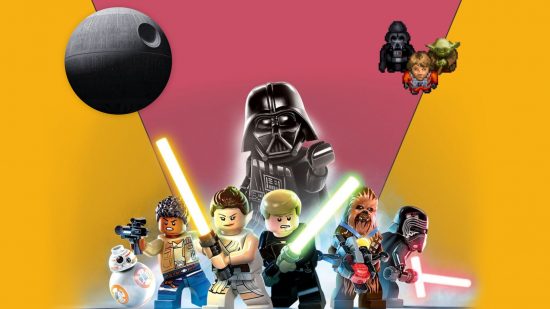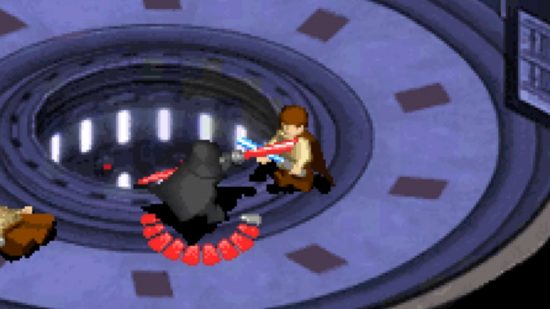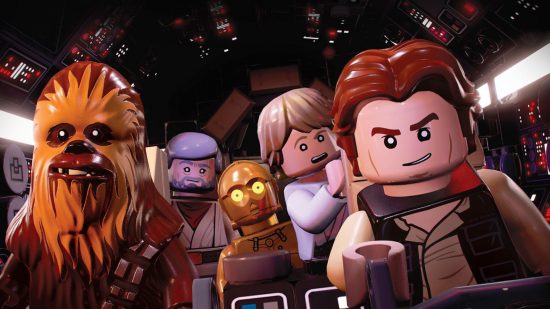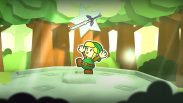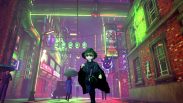There’s nothing quite like having a whole universe in the palm of your hands. With a long history of handheld Star Wars games, countless of us grew up piloting X-Wings, battling Vader, and catching up with Yoda in Dagobah. So, for this Stay Wars day, a.k.a May the Fourth, we thought we’d provide a history lesson in the long-spanning saga of handheld Star Wars games. So kick back, hand Chewy the controls, and let’s get into that galaxy far, far away.
As you might expect, the history of handheld Star Wars games begins with the true beginning of the handheld era – the release of the Game Boy. What you might now know is that the first game – 1992’s Star Wars – was a port of an NES title from just one year earlier, a platformer recounting the story of the original film with a black-and-white Luke Skywalker making his way through roughly an hour of gameplay. Yes, I said an hour. It was the nineties.
By 1994, the Game Boy would have three Star Wars titles, one for each cinematic episode in the saga, but it wasn’t exclusively the work of LucasArts (known earlier as Lucasfilm Games). Instead, NMS Software handled the ports for the original Star Wars and Star Wars: The Empire Strikes Back. Now if you’re not familiar with NMS, that’s no big surprise, considering the company liquidated in 1998. Ironically, the last game the company put out is a Star Trek title. Probably the best argument yet for Lucas’ series being the better of the two.
Following the original trilogy of Star Wars Game Boy games, the series went dormant for a while, hiding out for the perfect time to return like Luke Skywalker himself. The perfect time would be 1999, with the dawn of a new era for Lucas’ saga with the release of Star Wars: The Phantom Menace in cinemas.
Still, before we get into the rejuvenation of the Star Wars universe, there’s something of a stinker to cover. While all three of the original Game Boy games picked up mixed reviews, a 1999 port of PC’s Star Wars: Yoda Stories would mark a series low for the franchise’s handheld titles. While fans of the PC version were few and far between, critics would lambast the Game Boy Colour port, citing poor gameplay, bad graphics, and a boring core concept. All these years later, Yoda Stories still has the unfortunate status as the worst ever Game Boy Colour game, according to IGN’s archive of reviews.
1999 wasn’t all bad for Star Wars games, though. A Game Boy Colour version of Star Wars Episode I: Racer kept handheld gamers in the loop, while a proper playable version of the film’s story would arrive in 2000 with Star Wars Episode I: Obi-Wan’s Adventures – the first game on this list specifically made for portable hardware. This isometric adventure retells the main beats from Phantom Menace from Obi-Wan’s perspective, including the famed Darth Maul fight. Unfortunately, you don’t get to see a pixelated version of Liam Neeson’s Qui-Gon Jin falling to his death, but otherwise, it’s a solid Star Wars experience.
The rest of the prequel adaptations would arrive on Game Boy Advance, with the arrival of Nintendo’s next-level handheld console in 2001. It also marks what I call the lukewarm – or Luke Skywalker-warm, eh? – era of handheld Star Wars games, with Jedi Power Battles and Attack of the Clones garnering Metacritic scores of 58/100 and 38/100, respectively.
Not content with sullying just the prequel series with sub-par titles in the gap between the second and third instalments, both Star Wars: Flight of the Falcon and Star Wars Trilogy: Apprentice of the Force would arrive on Game Boy Advance in 2003 and 2004. While neither blew critics away, with Flight of the Falcon picking up miserable reviews on launch, Apprentice of the Force marks a slight uptick in the franchise’s handheld fortunes, plus the beginning of a fruitful relationship with Ubisoft.
Strangely enough, it would take the development of another series to make Apprentice of the Force the memorable GBA experience it still is. Ubisoft made the playable version of the original trilogy using the engine they had developed for Prince of Persia: Sands of Time, copying not only the 2D exploration from this game but also the Prince’s ability to slow time. The game explains this newfound Jedi ability as part of the force, but we’re pretty sure that if that were canon then we’d have seen Yoda slow down time to avoid the massacre of Jedi younglings, but hey, you do you Ubisoft.
With the relative success of Apprentice of the Force, Ubisoft Montreal earned the chance to take on the GBA version of the final instalment in the prequel trilogy. It’s a good job they did, too, with the GBA port of Revenge of the Sith earning the highest Metacritic score for the console with a respectable 73/100. Still, it was a time when many handheld players started to feel a little left behind, with Star Wars Battlefront dominating the conversation with its console-exclusive recreations of some of the series’ most intense and memorable battles.
However, in doing my research for this piece, I found out that those jealous of the console gamers playing Battlefield did have an alternative in a mobile version. Yes, a 2005 mobile version of Star Wars Battlefront. Imagine that for a second. While not awful by the standards of the time, looking back on this mobile version now makes us realise just how lucky we are in 2023, with the primitive FPS gameplay looking pretty antiquated even at launch.
Towards the end of the Game Boy Advance era, a major change was coming to the way we experience the Star Wars universe. In short, it was now made of Lego. Darth Vader? Lego. Tattooine? Lego. Traveller’s Tales knew they had a hit in Star Wars Lego games, so they made a lot of them in a short space of time, making it so if I try and think about that period in my own life, all I can see is the outline of a golden bricks and a Lego Chewbacca.
Lego Star Wars: The Video Game arrived in 2005, with Griptonite Games handling the GBA port, followed by Lego Star Wars II: The Original Trilogy on both GBA and the brand-spanking new Nintendo DS. The Original Trilogy marks the passing of the baton between handheld eras, with the DS’ dual screens offering a wealth of possibilities to the developers. Unfortunately, the first outing didn’t realise those possibilities, with Amaze Entertainment GBA and DS versions of the second Lego Star Wars game picking up Metacritic scores of 55 and 47, respectively.
What would follow from the first Lego Star Wars game til now is a slew, a squadron of Lego Star Wars titles for Nintendo DS, mobile, 3DS, and eventually, Nintendo Switch. Some titles arrived on the PSVita too, but we don’t talk about the Vita. All these years later and you can enjoy the full Lego saga in Lego Star Wars: The Skywalker Saga on Nintendo Switch, with the culmination of the series picking up a near series-high of 82/100 and Metacritic and a 9/10 from our good selves.
Of course, as a mobile-orientated site, we need to talk about the plethora of Star Wars mobile games. To date, there are over 30 Star Wars mobile titles, ranging from pre-smartphone platformers and simulators like Grievous Getaway and Battle Above Coruscant to modern-day Apple Arcade exclusives like Star Wars: Castaways. However, one mobile title stands above the rest, with only 2015’s Star Wars: Galaxy of Heroes surviving and thriving through the swathe of mobile titles we’ve seen in the last ten years, with an active community of players still engaging in lightsaber battles and collecting new Jedi heroes to this day.
The modern era of handheld Star Wars games is the most exciting for franchise fans. With Apple Arcade exclusives, a space fleet of classics ported to Switch, and plenty of ways to emulate the Game Boy and Game Boy Advance glory days, you truly can experience the lore of Lucas’ pride and joy in whichever way you prefer. Sure, titles like Star Wars: Jedi Survivor still defy Switch players, but with a library of remasters you can fall into like Boba Fett falling into the Sarlac Pit, you too might take five years to come out the other side.
In terms of the future of handheld Star Wars games, there’s plenty to look forward to. Star Wars: Hunters is coming to Switch and mobile at some point in 2023, with us handheld heroes finally getting one over on the home console team for all those years they had Battlefront while we had to make do with poor GBA ports. The future is slightly less certain for the Lego Star Wars titles, with The Skywalker Saga seemingly the culmination of all the series, but with Andor, The Mandalorian, and other Star Wars series adding to the lore, who knows? Maybe we might meet a little Lego Grogu before too long.

If there’s a handheld Star Wars game that we didn’t mention here, can you blame us? There are nearly more handheld Star Wars games than the entire Pocket Tactics team could count with our collective hands. Still, those hands would be better for instead delving back into some of these titles, from the nostalgia-laden to the modern masterpieces, each offering a warp-speed trip to Lucas’ iconic science-fantasy universe.
What I’ve realised in writing this is that Star Wars has become the blueprint for other IPs on integrating your universe into just about anything. Pinball. Lego. Hero collectors, racing games, and RPGs. We’ve seen countless series adopt the approach, from Harry Potter to Lord of the Rings and everything else in between. Still, with swinging lightsabers in Lego Star Wars on DS and fading pixelated memories of powering through Apprentice of the Force, one thing is certain. It doesn’t get much better than Star Wars.
There you have it, our history lesson on the handheld Star Wars games. While you’re here, see what you could pick up with our picks for the best Star Wars games, or try a different universe with our Honkai Star Rail codes and Honkai Stair Rail tier list.
